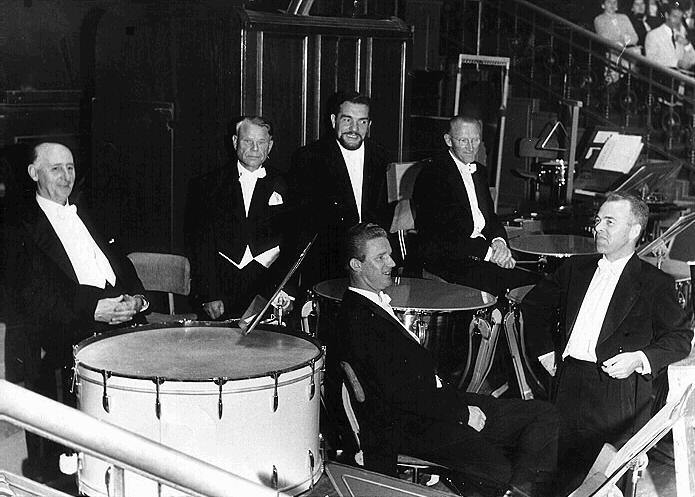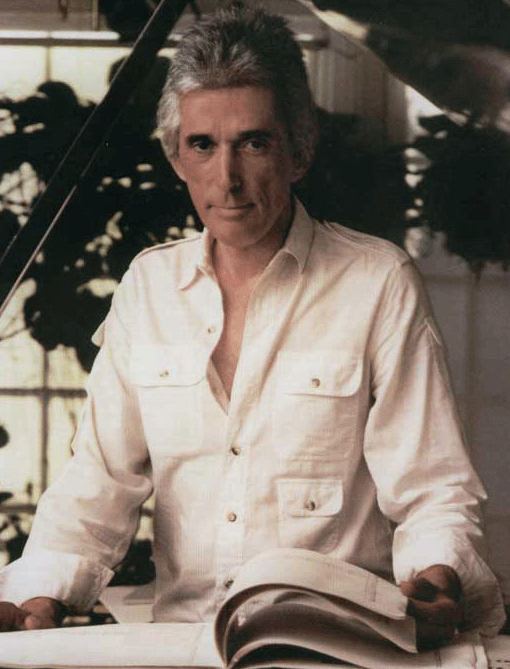 Ah, the stories they could tell. Can't you imagine them plying their trade in some medieval torture chamber? Hereís a catalog of their more exotic instruments. Iím leaving out all the timpani, drums and cymbals.
Ah, the stories they could tell. Can't you imagine them plying their trade in some medieval torture chamber? Hereís a catalog of their more exotic instruments. Iím leaving out all the timpani, drums and cymbals.And think of all those empty bars you have to count as a percussionist to make your entrance and usually, if you screw it up, everybody but the guy in the ticket booth outside will know it. The main requirement for a percussion instrument in most cases is--it has to be loud! You donít usually see them because they hide them in the back of the orchestra. Itís like they need to be hidden away like an ancient alchemist so you canít see them work, especially if youíre playing something like a lionís roar, a wind machine, or a flexatone. And castanets? Those are only supposed to be played by sexy Spanish ladies wearing revealing dresses while they are dancing. Believe me, if there were someone like that playing castanets in an orchestra, they would be up front by the conductor.
Orchestral castanets arenít very sexy though because normally they are not held in the hand. Instead they are mounted on a table. But here is how the castanets sound in two brief passages from the third movement of the Second Violin Concerto by Prokofiev. Listen!
Itís sort of unexpected. Suddenly youíre in a bar in Barcelona!
The group of percussionists huddle together around a group of instruments collectively known as a battery, and yes, itís because thereís a lot of beating going on, although sometimes ingenious things happen with the percussionists. I think it was arranger ad conductor Lalo Schifrin ("Mission Impossible") who was the first to bounce tennis balls over the undampened strings of a piano. You want to hear the piano really used as a percussion instrument. Find the old recording of composer Henry Cowell playing his work Banshee on the piano.
Basically there are two types of percussion instruments: pitched and un-pitched. In the pitched camp are things like xylophones, marimbas, glockenspiels, vibraphone, bell plates, the celesta, and the piano, and gongs (Yes! Most gongs are considered pitched!) Itís tam-tams that are considered un-pitched, as well as timpani (since their pitches are variable, not fixed), any drum, tambourines, castanets, whips (like the one used in Leroy Andersonís ďSleigh Ride), triangle, cymbals, and anything else. Hereís a picture of the Holland Radio Philharmonic Percussion Players in 1965.
 Ah, the stories they could tell. Can't you imagine them plying their trade in some medieval torture chamber? Hereís a catalog of their more exotic instruments. Iím leaving out all the timpani, drums and cymbals.
Ah, the stories they could tell. Can't you imagine them plying their trade in some medieval torture chamber? Hereís a catalog of their more exotic instruments. Iím leaving out all the timpani, drums and cymbals.
Small percussion:
Triangle anonymous
Triangle Thein 58324
Triangles Studio 49, 2 sets of 4
Triangles 12 various anonymous
Tambourine Black Swamp
Tambourine Grover German Silver
Tambourine Grover German Silver
Tambourine Lefima
Tambourine Hayman
Tambourine Ludwig (metal ring)
Tambourine Grover (small)
Tambourine Premier (small)
Castanets on handles, Frank Epstein Symphonic Castanets, 2 pairs
Castanets on handles, Black Swamp, 2 pairs
Castanets, mounted, Holland Percussion, 1 pair
Castanets, mounted, PPP, 2 pairs
Woodblocks Playwood, set of 4
Woodblocks Smalbrugge, set of 8
Woodblocks 10 various anonymous
Temple blocks Rythmes & sons, set of 6
Maracas, 14 pairs, different types
Claves, 3 pairs anonymous authentic
Claves, 8 pairs LP
Guiro Percuton
Guiro Dixon
Guiro LP
Guiro anonymous
Shokolo Supercussion
Cowbell Gon Bops
Cowbell Dixon
Cowbell anonymous
Slapstick Ludwig
Slapstick anonymous
Whip Adams
Whips, 6 different types, anonymous
Ratchets 2 Ludwig
Rattle, large with dynamic handle, Kolberg
Rattle, large anonymous (scare crow)
Sistra, 3 different sizes
Sleighbells Leedy
Sleighbells Premier
Bell tree, UFIP
Bell tree, Supercussion
Turkish crescent, Kolberg
Bar chimes LP
Temple bowls, 8 different sizes
Flexatone Carroll
Flexatone Carroll
Flexatone LP
Flextone LP, large
Vibraslaps 2 anonymous
Cabasa LP
Quica LP
Quica Gope 732
Logdrum Kolberg 1581
Logdrum Kolberg 1582
Logdrum Kolberg 1583
Effect instruments:
2 Thundersheets Adams
Windmachine 999PPP
Lions roar Kolberg
Lions roar, handmade from large tomtom
Rainmaker Meinl 'Professional Fibreglass'
2 Geophones (ocean drums) Remo
High & low siren, Kolberg
22 Almglocken, authentic, different types and sizes
10 Doorbells, old fashioned, different sizes
2 Sanctus bells
Camel bells
Elephant's bell (Sarka)
Typewriter Remington Rand
2 Super soakers (for performing 'flaques sonores' in Satie's Parade)
Musical saw Carl Feldmann
Lujon anonymous
6 Brake drums, different types
3 Coils
5 Metal pipes
7 Metal blocks
8 Anvils
5 Childrens drums (tin)
4 Ocarinas, different sizes
6 Slide whistles Acme
Cuckoo machine, tunable
5 Bird calls (Nightingale)
2 Car horns
Korean wooden clapper
 Hereís a picture of West Coast composer Phillip Lambro who has had an unusual career. He was a friend of Stokowski, and the great Leopold even conducted some of his music when Lambro was about 24 years old. His adventures in Hollywood are well-documented such as the fact that he was the original composer contacted to write the score for the Roman Polanski film, Chinatown. Of course it was eventually Jerry Goldsmith who wrote the music, but since Lambro had already been contracted, his music is featured on the trailer, which you can hear if you have the Collectorsí Edition of the Chinatown DVD. He has written some fascinating books about the various people and celebrities he has known.
Hereís a picture of West Coast composer Phillip Lambro who has had an unusual career. He was a friend of Stokowski, and the great Leopold even conducted some of his music when Lambro was about 24 years old. His adventures in Hollywood are well-documented such as the fact that he was the original composer contacted to write the score for the Roman Polanski film, Chinatown. Of course it was eventually Jerry Goldsmith who wrote the music, but since Lambro had already been contracted, his music is featured on the trailer, which you can hear if you have the Collectorsí Edition of the Chinatown DVD. He has written some fascinating books about the various people and celebrities he has known.
Phillip has also written an impressive work for Percussionist called Two Pictures for Percussionist and Orchestra. It was premiered by John Beck with the Rochester Philharmonic, and hereís an excerpt just to give you an idea of the way a solo percussionist works along with an orchestra. Listen!
If you want to find out more about this percussion work, Phillip Lambro, his music or his books, please visit Wimbledon/Trigram Music, Inc.
If you need to leave, Go to initial page of site.
If you are interested in advertising a music-related business in the pages of the classroom, please send us an e-mail regarding rates by clicking here.